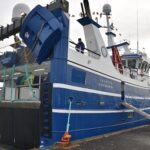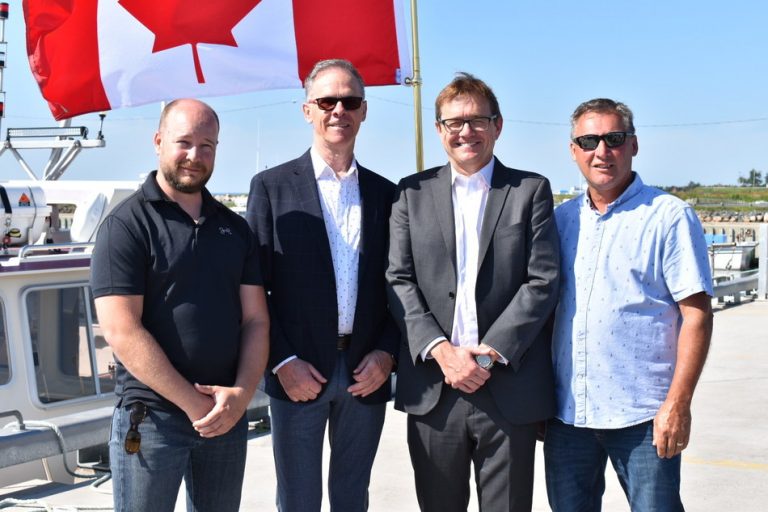Tag Archives: Great Lakes
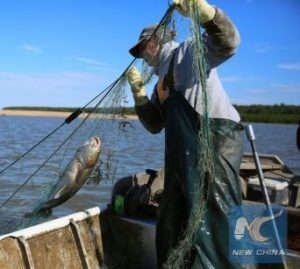
Illinois Lt. Gov: Michigan’s carp money would be too little, too late
It’s not that Illinois is being rude, or even dismissive, it’s just that Michigan’s promise of $8 million to help keep Asian carp in the Illinois River doesn’t solve today’s problem, according to the Rauner administration. Illinois Lt. Gov. Evelyn Sanguinetti said Illinois needs to focus on its Asian carp problem immediately.,,“He indicated that we need to act now.,,, “Imagine if we were able to take the money and double down on our commercial fishing. That’s where we are going to see a bigger impact,” Sanguinetti added. >click to read<16:35
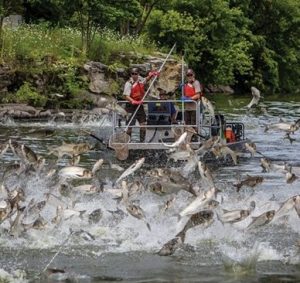
Pricetag of Asian Carp Defense Project Climbs to $778 Million
The forecasted pricetag of a planned Asian carp defense system near Joliet, Illinois that would hopefully prevent the invasive species from infiltrating the Great Lakes has now climbed to $778 million, up from an initial estimate of $275 million, according to an update last week from the U.S. Army Corps of Engineers. As reported by the Detroit News, the project, which would be finished sometime between 2025 and 2027, will now be reviewed by state and federal agencies. If Congress funds the initiative, an electric barrier would be installed as well as underground speakers to essentially blast noise at fish to stop them in their tracks northbound. >click to read<12:12

Turning an invasive problem into a bait solution
With concerns growing over a likely bait shortage in the lobster industry in Maine and Canada due to a drastic cut in the upcoming season’s herring quota, Nova Scotia resident Patrick Swim has a possible solution. Swim thinks he can solve the bait shortage by harvesting an invasive species. Silver carp is one of the four species of the invasive Asian carp (silver, bighead, grass, and black) that have placed the Great Lakes water system at risk. >click to read<19:45

$300 million Asian Carp control plan needs study, says Lt. Gov.
Another proposed step to prevent Asian carp in the Illinois River from invading the Great Lakes needs a careful look, Illinois Lt. Gov. Evelyn Sanguinetti said Monday morning aboard the twin-screw tugboat “Windy City” while it plied the Illinois River at Ottawa. In July, the Army Corps of Engineers released a new carp control system that would be installed at the Brandon Roads Lock and Dam on the Des Plaines River in Joliet. Of the $300 million cost of the installation the state is being asked to put up $90 million, she said, and then pay $10 million annually in maintenance expenses,, “The actual (Asian carp) population has decreased 68 percent because of commercial fishing and other nonstructural solutions that are working,” said Del Wilkins. click here to read the story 15:43
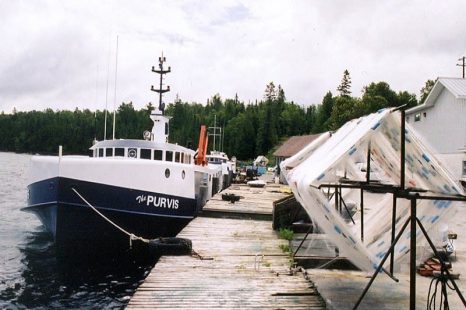
Training Great Lakes captains – Online education makes Marine Institute a hub for Canadian harvesters
When you think about Ontario, commercial fisheries aren’t something that necessarily comes to mind. But there is a thriving industry on the Great Lakes. In fact, according to the Ontario Commercial Fisheries’ Association (OCFA), “Ontario is home to the largest freshwater fishery in North America.”,,, But much as with Newfoundland and Labrador fisheries, the province of Ontario’s skilled fishers are aging. “The captains are becoming older and starting to retire,” said Jane Graham, executive director of the OCFA. “We wanted to have people trained to step into the role.”,,, The online version of Fishing Master Class IV program started as a pilot project back in 2010 to meet the same needs as those of the OCFA. The initiative was developed by the Marine Institute, in partnership with the Canadian Council of Professional Sea Harvesters and the Department of Fisheries and Aquaculture, as a way of improving training in the industry and filling the gap in (s)killed harvesters. click here to read the story 18:04
Telling it like it is! NOAA has done enough already and has failed in spectacular fashion
 One wonders why a Marine Sanctuary is needed to protect shipwrecks. Sanctuaries are usually established to protect ecosystems. The typical reason for establishing a Sanctuary off our shores is inapplicable because our native ecosystem has been destroyed. After the opening of the Saint Lawrence Seaway in 1959 NOAA was assigned the responsibility of protecting the Great Lakes from invasive species, essentially making the entire region a sanctuary. NOAA has failed in spectacular fashion.,, NOAA allowed the Lamprey Eel and Alewife into our native waters shortly after the Seaway opened. These and other foreigners decimated our native fishery. Smelt survived until the 1980’s but now they too have been displaced by some other invasive species that NOAA failed to protect us from, was it the Quagga Mussel or the Round Gobi? (must read) Click here to read the letter. 10:04
One wonders why a Marine Sanctuary is needed to protect shipwrecks. Sanctuaries are usually established to protect ecosystems. The typical reason for establishing a Sanctuary off our shores is inapplicable because our native ecosystem has been destroyed. After the opening of the Saint Lawrence Seaway in 1959 NOAA was assigned the responsibility of protecting the Great Lakes from invasive species, essentially making the entire region a sanctuary. NOAA has failed in spectacular fashion.,, NOAA allowed the Lamprey Eel and Alewife into our native waters shortly after the Seaway opened. These and other foreigners decimated our native fishery. Smelt survived until the 1980’s but now they too have been displaced by some other invasive species that NOAA failed to protect us from, was it the Quagga Mussel or the Round Gobi? (must read) Click here to read the letter. 10:04
Invasive Asian carp less than 50 miles from Lake Michigan
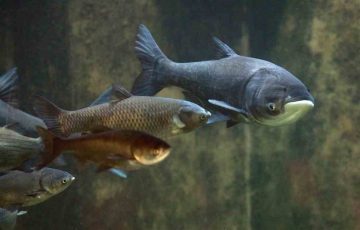 The news is mixed as Great Lake states and the federal government continue to devote money and brainpower to stopping a potential Great Lakes ecological disaster — invasive Asian carp species making their way from the Mississippi River into Lake Michigan. First the good news: The leading edge of the mass of bighead and silver carp hasn’t made much progress lately up the Mississippi and connected rivers toward Lake Michigan. Now the bad news: The younger fish — juveniles — are moving closer, the evidence shows. And they can do more damage. “The bottom line is that the juvenile front is advancing, and made a big jump last year,” said Joel Brammeier, president and CEO of the nonprofit Alliance for the Great Lakes. “And we still don’t have a permanent solution in place that’s going to solve this problem.” Read the story here 08:59
The news is mixed as Great Lake states and the federal government continue to devote money and brainpower to stopping a potential Great Lakes ecological disaster — invasive Asian carp species making their way from the Mississippi River into Lake Michigan. First the good news: The leading edge of the mass of bighead and silver carp hasn’t made much progress lately up the Mississippi and connected rivers toward Lake Michigan. Now the bad news: The younger fish — juveniles — are moving closer, the evidence shows. And they can do more damage. “The bottom line is that the juvenile front is advancing, and made a big jump last year,” said Joel Brammeier, president and CEO of the nonprofit Alliance for the Great Lakes. “And we still don’t have a permanent solution in place that’s going to solve this problem.” Read the story here 08:59
Great Lakes commercial fishermen get hands-on experience in emergency procedures
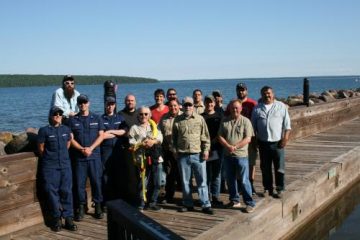 To assist with this effort Michigan Sea Grant coordinated six Drill Conductor Training courses held throughout the Great Lakes region recently to help Great Lakes commercial fishing vessel captains fulfill U.S. Coast Guard regulations related to instruction, drills and safety orientations, and onboard emergency instruction. Commercial fishers are required to practice monthly emergency drills that cover ten contingencies spelled out in the regulation. Persons conducting these drills must have passed a Drill Conductor Training course. The Alaska Marine Safety Education Association (AMSEA) assisted Michigan Sea Grant with these training efforts that were held in Michigan and Wisconsin. Read the rest here 16:54
To assist with this effort Michigan Sea Grant coordinated six Drill Conductor Training courses held throughout the Great Lakes region recently to help Great Lakes commercial fishing vessel captains fulfill U.S. Coast Guard regulations related to instruction, drills and safety orientations, and onboard emergency instruction. Commercial fishers are required to practice monthly emergency drills that cover ten contingencies spelled out in the regulation. Persons conducting these drills must have passed a Drill Conductor Training course. The Alaska Marine Safety Education Association (AMSEA) assisted Michigan Sea Grant with these training efforts that were held in Michigan and Wisconsin. Read the rest here 16:54
Goldfish – A lucrative Great Lakes commercial catch
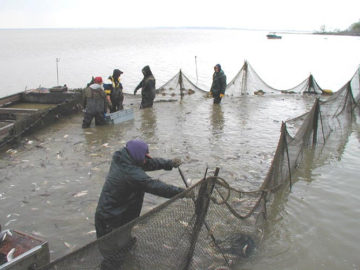 Whenever Dave DeLong brings in one of his Maumee Bay seine nets, there’s almost always one or two distinctive bright orange fish swimming around the writhing mass of bullhead, catfish and carp. DeLong, a Lake Erie commercial fisherman, makes a living hauling live fish to the Luna Pier Harbor Club, where his catch is weighed and sold. He’s been fishing for 45 years on Lake Erie and goldfish have been part of that catch every year.”We used to throw them away,” he said. Not anymore. Goldfish — larger versions of the species found in household aquariums — have been a part of the Great Lakes ecosystem for a long, long time. While that’s really no secret, most would be surprised to learn just how many actually inhabit the bi-national waters. Photo gallery, Read the rest here 13:16
Whenever Dave DeLong brings in one of his Maumee Bay seine nets, there’s almost always one or two distinctive bright orange fish swimming around the writhing mass of bullhead, catfish and carp. DeLong, a Lake Erie commercial fisherman, makes a living hauling live fish to the Luna Pier Harbor Club, where his catch is weighed and sold. He’s been fishing for 45 years on Lake Erie and goldfish have been part of that catch every year.”We used to throw them away,” he said. Not anymore. Goldfish — larger versions of the species found in household aquariums — have been a part of the Great Lakes ecosystem for a long, long time. While that’s really no secret, most would be surprised to learn just how many actually inhabit the bi-national waters. Photo gallery, Read the rest here 13:16
Great Lakes Fisheries Heritage Trail: Evelyn S. still making history
A new Great Lakes Fisheries Heritage Trail offers opportunity to explore the past, present and future of the lakes through the lens of fish and fishing (See Part 1, series introduction). In this article, we visit South Haven and the Michigan Maritime Museum to explore commercial fishing heritage of west Michigan as told through the historic commercial fishing vessel, Evelyn S. The Evelyn S. was built in 1939 by Sturgeon Bay Boat Works William Selman Fisheries of Manistique, Mich. She fits the typical wooden gill net fish tug design so prevalent on the waters during this period. Read the rest here 09:56
Michigan state officials recommend against Great Lakes fish farms
 Three state agencies released a report recommending Michigan not pursue commercial fish farming operations in the Great Lakes because of several environmental and economic risks. The state departments of agriculture and rural development, environmental quality and natural resources released a report Wednesday on the controversial topic and proposals regarding net-pen aquaculture — a practice that involves raising fish in underwater nets, or solid structure cages serving as pens, also known as fish farming — in northern Lakes Huron and Michigan. The agencies concluded the report by urging the state not to pursue commercial net-pen aquaculture in the Great Lakes at this time. Read the rest here 11:31
Three state agencies released a report recommending Michigan not pursue commercial fish farming operations in the Great Lakes because of several environmental and economic risks. The state departments of agriculture and rural development, environmental quality and natural resources released a report Wednesday on the controversial topic and proposals regarding net-pen aquaculture — a practice that involves raising fish in underwater nets, or solid structure cages serving as pens, also known as fish farming — in northern Lakes Huron and Michigan. The agencies concluded the report by urging the state not to pursue commercial net-pen aquaculture in the Great Lakes at this time. Read the rest here 11:31
Battle brewing over fish farming in Great Lakes
 Supporters of the idea say Michigan is perfectly positioned to be a world leader in freshwater aquaculture and home to all the science, engineering and manufacturing that would accompany this growing part of the world’s food economy. But critics counter the Great Lakes are no place for so-called net-pen fish farming because of the higher risk of disease and water pollution that accompanies this method. Read the rest here 13:40
Supporters of the idea say Michigan is perfectly positioned to be a world leader in freshwater aquaculture and home to all the science, engineering and manufacturing that would accompany this growing part of the world’s food economy. But critics counter the Great Lakes are no place for so-called net-pen fish farming because of the higher risk of disease and water pollution that accompanies this method. Read the rest here 13:40
Chatham-Kent’s amazing fishing economy sometimes overlooked
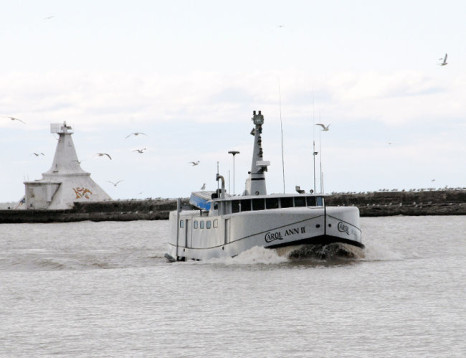 There are currently 16 fish processors located in various regions throughout Ontario. Here in Chatham-Kent, we have three of them, so we are well represented. The economic impacts of Lake Erie’s commercial fishing sector are significant. For the fishing sector on Lake Erie, they account for over 700 direct and indirect jobs with a GDP of over $28 million. The Lake Erie fish processing sector accounts for close to 800 direct and indirect jobs, with a GDP of over $77 million. Read the rest here 19:49
There are currently 16 fish processors located in various regions throughout Ontario. Here in Chatham-Kent, we have three of them, so we are well represented. The economic impacts of Lake Erie’s commercial fishing sector are significant. For the fishing sector on Lake Erie, they account for over 700 direct and indirect jobs with a GDP of over $28 million. The Lake Erie fish processing sector accounts for close to 800 direct and indirect jobs, with a GDP of over $77 million. Read the rest here 19:49
What European demand for caviar means for a Great Lakes fish
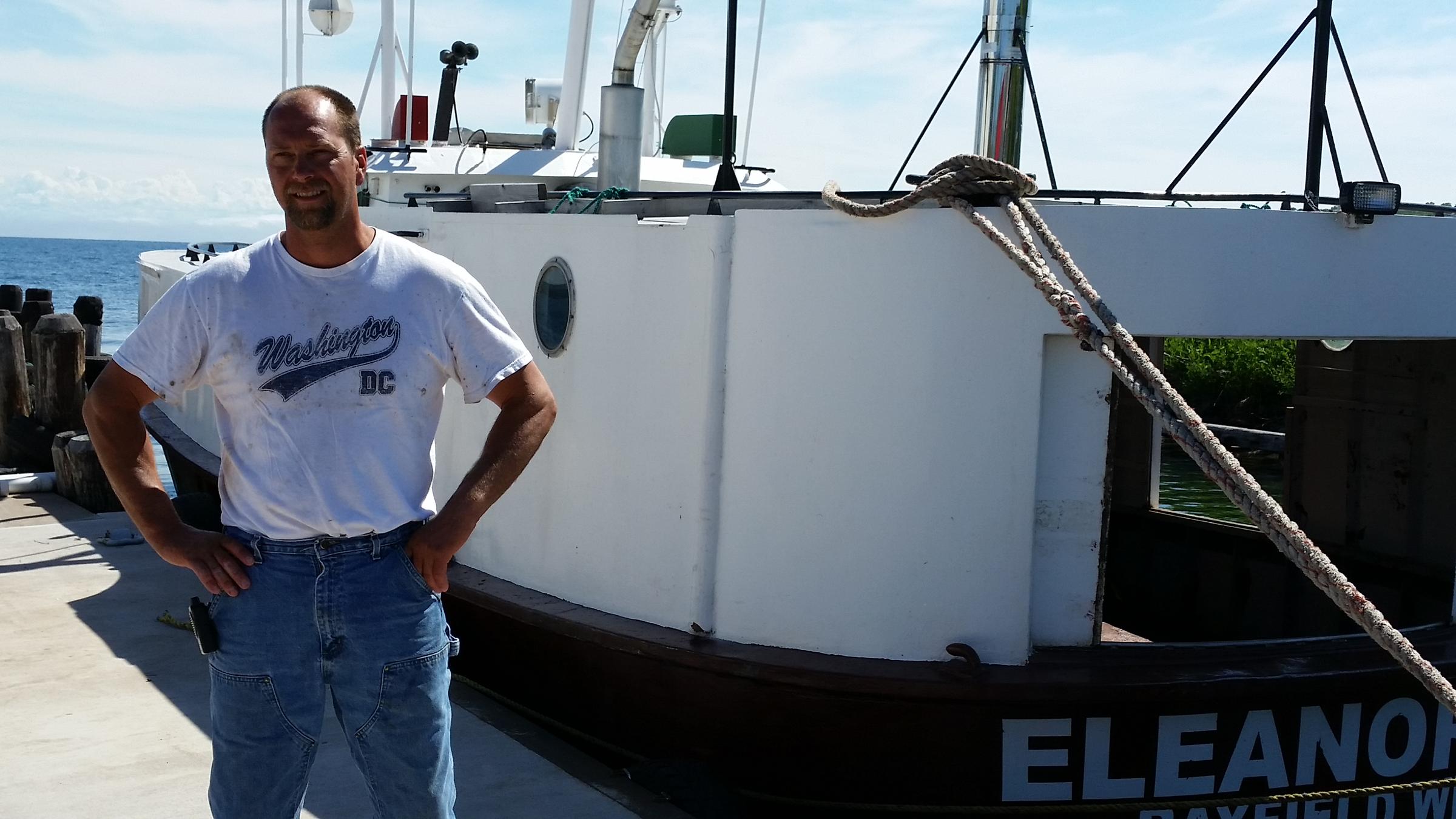 Lake Superior is the largest freshwater lake in the world by surface area, and it has something the other Great Lakes don’t — stable populations of mostly native fish species. But scientists say a key fish in Superior’s food web is now in trouble because of mild winters and an appetite for caviar in Europe. There wasn’t much demand for lake herring until a few years ago. Craig Hoopman says it used to be fed to mink and used as fertilizer. He says around 2007, Scandinavians started buying lake herring eggs, or roe, for caviar. Listen, Read the rest here 12:11
Lake Superior is the largest freshwater lake in the world by surface area, and it has something the other Great Lakes don’t — stable populations of mostly native fish species. But scientists say a key fish in Superior’s food web is now in trouble because of mild winters and an appetite for caviar in Europe. There wasn’t much demand for lake herring until a few years ago. Craig Hoopman says it used to be fed to mink and used as fertilizer. He says around 2007, Scandinavians started buying lake herring eggs, or roe, for caviar. Listen, Read the rest here 12:11
Michigan Considers Controversial Commercial Net-Pen Aquaculture in Huron and Michigan
 Several State agencies are looking at proposals to allow commercial net-pen aquaculture on the Great Lakes. The practice is controversial because of environmental concerns. WDET’s Amy Miller spoke with Tammy Newcomb; Senior Policy Advisor for the Department of Natural Resources. She says Ontario has allowed a few net-pens near Georgian Bay and now there are two Michigan proposals. This week the State is holding two public hearings on the two Great Lakes net-pen aquaculture proposals. Listen to the report here 08:29
Several State agencies are looking at proposals to allow commercial net-pen aquaculture on the Great Lakes. The practice is controversial because of environmental concerns. WDET’s Amy Miller spoke with Tammy Newcomb; Senior Policy Advisor for the Department of Natural Resources. She says Ontario has allowed a few net-pens near Georgian Bay and now there are two Michigan proposals. This week the State is holding two public hearings on the two Great Lakes net-pen aquaculture proposals. Listen to the report here 08:29
As Our Oceans Degrade, The Environmentalist Network Stays Focused on their Overfishing Bread and Butter
![]()
Canadian scientists warn of artificial sweeteners in oceans. It means that up to 72 metric tonnes (160,000 pounds) of sweetener are pouring into Lake Erie. Because the sweeteners — used in products like diet soda, chewing gum, yogurt and as sugar replacements in tea and coffee to avoid weight gain — cannot be broken down by the human body, the artificial sweeteners pass right through. They cannot be broken down by wastewater treatment plants either, meaning the undiluted sweeteners enter the water supply used as drinking water for humans and animals. Read the rest here 10:08
Commercial fishing trial worries Lake Huron anglers
 When the Michigan Department of Natural Resources announced a three-year trial to allow a commercial fishery to pursue whitefish in southern Lake Huron, recreational anglers took to social media to express their outrage. The state also is hoping that by allowing the commercial fisherman, Dana Serafin, to move his operation to southern Lake Huron, some of the fishing pressure in Saginaw Bay will be relieved. the state also announced a panel to look at the possible effects of proposals to raise fish in net pens in the Great Lakes. Read the rest here 20:30
When the Michigan Department of Natural Resources announced a three-year trial to allow a commercial fishery to pursue whitefish in southern Lake Huron, recreational anglers took to social media to express their outrage. The state also is hoping that by allowing the commercial fisherman, Dana Serafin, to move his operation to southern Lake Huron, some of the fishing pressure in Saginaw Bay will be relieved. the state also announced a panel to look at the possible effects of proposals to raise fish in net pens in the Great Lakes. Read the rest here 20:30
Scientific panel will evaluate proposals to establish commercial fish farms in Great Lakes
 Department of Environmental Quality officials said in March they’d heard from two operators interested in raising rainbow trout in netted enclosures in Lakes Michigan and Huron. They would take fish from small hatcheries and raise them until large enough for the consumer food market. Among members are scientists with the NOAA Great Lakes Ecological Laboratory in Ann Arbor, the Great Lakes Fishery Commission, Michigan Sea Grant and others. The chairman is Roy Stein, a professor emeritus at Ohio State University. Bad idea Read the rest here 13:14
Department of Environmental Quality officials said in March they’d heard from two operators interested in raising rainbow trout in netted enclosures in Lakes Michigan and Huron. They would take fish from small hatcheries and raise them until large enough for the consumer food market. Among members are scientists with the NOAA Great Lakes Ecological Laboratory in Ann Arbor, the Great Lakes Fishery Commission, Michigan Sea Grant and others. The chairman is Roy Stein, a professor emeritus at Ohio State University. Bad idea Read the rest here 13:14
Smeltdown: Small fish continues Great Lakes vanishing act
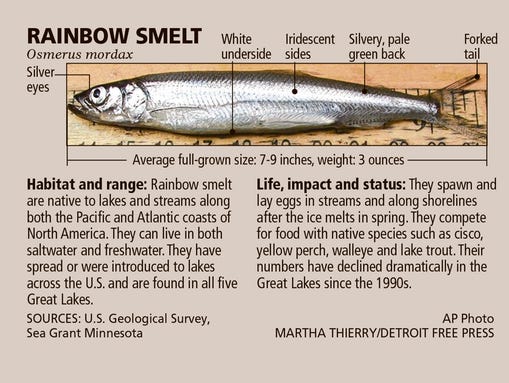
Like so many fish people associate with the Great Lakes, the rainbow smelt is an invasive species. The approximately 6-inch fish is native to the Atlantic and Pacific oceans, but moves into freshwater to spawn. It was first stocked in Crystal Lake in Benzie County in 1912, after several unsuccessful attempts to stock smelt in the St. Mary’s River to support another transplanted fish, Atlantic salmon. Smelt were found in Lake Michigan in 1923 and then spread throughout the Great Lakes. The commercial harvest of smelt on the Great Lakes reached 4.8 million pounds by 1941. Read the rest here 10:03
One Great Lakes invasive species may have found a niche
 Can invasive species be good news – rather than bad – for native fish in the Great Lakes? That sounds counterintuitive, but a new study shows that the invasive round goby has become an important food source for several native species, especially smallmouth bass, but with benefits also for yellow perch and walleye. The study calls the round goby “one of the most successful aquatic invaders” in the Great Lakes. Read the rest here 18:03
Can invasive species be good news – rather than bad – for native fish in the Great Lakes? That sounds counterintuitive, but a new study shows that the invasive round goby has become an important food source for several native species, especially smallmouth bass, but with benefits also for yellow perch and walleye. The study calls the round goby “one of the most successful aquatic invaders” in the Great Lakes. Read the rest here 18:03
Great Lakes fishery managers need insight on climate change impacts
 Great Lakes fishery managers worry that their operations may be harmed by invasive species, habitat loss in the long run, according to a new study. Read the rest here 08:52
Great Lakes fishery managers worry that their operations may be harmed by invasive species, habitat loss in the long run, according to a new study. Read the rest here 08:52
Given the cold water going into winter, the current “Ice Breaking Fleet” operating on the Great Lakes may be inadequate this year
 A recent WUWT story notes the well below normal water temperature of the Great Lakes, some 6 degrees colder than last year. David DuByne writes, and a video follows: With the Great Lakes at 92% ice coverage during the winter of 2013-2014 and far below average water temperatures this year in the lakes, ice will form earlier and last longer into spring. This will have an effect on shipping and delivery of cargo throughout the region disrupting the Great Lakes Economy. Video, and read the rest here 12:36
A recent WUWT story notes the well below normal water temperature of the Great Lakes, some 6 degrees colder than last year. David DuByne writes, and a video follows: With the Great Lakes at 92% ice coverage during the winter of 2013-2014 and far below average water temperatures this year in the lakes, ice will form earlier and last longer into spring. This will have an effect on shipping and delivery of cargo throughout the region disrupting the Great Lakes Economy. Video, and read the rest here 12:36
Asian Carp Regional Coordinating Committee announces steps to protect lakes from carp
TRAVERSE CITY, Mich. — Authorities plan stepped-up monitoring and commercial fishing operations in the continuing effort to prevent Asian carp from reaching the Great Lakes. Read more here 11:13
Sea lampreys may be established in inland waterway
 The findings are preliminary but show the importance of determining whether the same thing is happening in other inland lakes, said Marc Gaden, spokesman for the Great Lakes Fishery Commission, which spends about $21 million a year keeping lamprey numbers down Read more@grandhaventribune 11:51
The findings are preliminary but show the importance of determining whether the same thing is happening in other inland lakes, said Marc Gaden, spokesman for the Great Lakes Fishery Commission, which spends about $21 million a year keeping lamprey numbers down Read more@grandhaventribune 11:51
Only half of drugs, other newly emerging contaminants removed from sewage treatment
 Only about half of the prescription drugs and other newly emerging contaminants in sewage are removed by treatment plants. More than 1,400 wastewater treatment plants in the United States and Canada discharge 4.8 billion gallons of treated effluent into the Great Lakes basin every day, according to the study.The scientists reviewed 10 years of data from wastewater treatment plants worldwide to see how well they removed 42 compounds that are increasingly showing up in the Great Lakes. more@envirohealthnews 17:09
Only about half of the prescription drugs and other newly emerging contaminants in sewage are removed by treatment plants. More than 1,400 wastewater treatment plants in the United States and Canada discharge 4.8 billion gallons of treated effluent into the Great Lakes basin every day, according to the study.The scientists reviewed 10 years of data from wastewater treatment plants worldwide to see how well they removed 42 compounds that are increasingly showing up in the Great Lakes. more@envirohealthnews 17:09
Tiny number of Asian carp could be big problem for the Great Lakes
 “This species will have a huge impact on the food web,” says Professor Cuddington. “Not only is it a fast-growing fish physically, but the population itself grows very quickly. A female can lay well over a million eggs a year, and with no known predators present in the Great Lakes, the Asian carp could dominate the waters and impact fisheries.” [email protected] 10:48
“This species will have a huge impact on the food web,” says Professor Cuddington. “Not only is it a fast-growing fish physically, but the population itself grows very quickly. A female can lay well over a million eggs a year, and with no known predators present in the Great Lakes, the Asian carp could dominate the waters and impact fisheries.” [email protected] 10:48
“microplastic” pollution in the Great Lakes
 Also, while it’s unknown where the ocean plastic came from, microscopic examination of Great Lakes samples has produced a smoking gun: many particles are perfectly round pellets. The scientists suspect they are abrasive “micro beads” used in personal care products such as facial and body washes and toothpaste. They’re so minuscule that they flow through screens at waste treatment plants and wind up in the lakes,, continued@usatoday
Also, while it’s unknown where the ocean plastic came from, microscopic examination of Great Lakes samples has produced a smoking gun: many particles are perfectly round pellets. The scientists suspect they are abrasive “micro beads” used in personal care products such as facial and body washes and toothpaste. They’re so minuscule that they flow through screens at waste treatment plants and wind up in the lakes,, continued@usatoday
Sen. Durbin criticizes plan to cut Great Lakes program funding
 Durbin says cuts would have a major impact on federal programs created to address ecological problems facing the Great Lakes, including fighting the spread of Asian carp. continued@wls
Durbin says cuts would have a major impact on federal programs created to address ecological problems facing the Great Lakes, including fighting the spread of Asian carp. continued@wls
Star editorial: Stopping Asian carp
The latest news about Asian carp isn’t good. In fact, it’s alarming. According to a report from the U.S. Geological Survey, the invasive and destructive fish may be able to spawn in far more of the Great Lakes’ tributaries including rivers in our region — than was first thought. continued@windsorstar
Former chief of fisheries for Michigan DNR John Robertson,receives C.D. “Buzz” Besadny Award
The C.D. “Buzz” Besadny Award is named for the former Wisconsin DNR secretary and  chair who epitomized the role of the partnerships in fisheries management. Such cooperation is particularly important in the Great Lakes basin as eight states, the Canadian province of Ontario, and U.S. tribes work with federal agencies and the Great Lakes Fishery Commission to manage the shared fishery. continued@grandhaventribune
chair who epitomized the role of the partnerships in fisheries management. Such cooperation is particularly important in the Great Lakes basin as eight states, the Canadian province of Ontario, and U.S. tribes work with federal agencies and the Great Lakes Fishery Commission to manage the shared fishery. continued@grandhaventribune


































